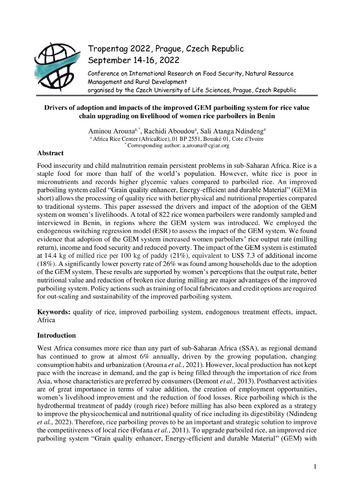Drivers of adoption and impacts of the improved GEM parboiling system for rice value chain upgrading on livelihood of women rice parboilers in Benin
Abstract
Food insecurity and child malnutrition remain persistent problems in sub-Saharan Africa. Rice is a
staple food for more than half of the world’s population. However, white rice is poor in
micronutrients and records higher glycemic values compared to parboiled rice. An improved
parboiling system called “Grain quality enhancer, Energy-efficient and durable Material” (GEM in
short) allows the processing of quality rice with better physical and nutritional properties compared
to traditional systems. This paper assessed the drivers and impact of the adoption of the GEM
system on women’s livelihoods. A total of 822 rice women parboilers were randomly sampled and
interviewed in Benin, in regions where the GEM system was introduced. We employed the
endogenous switching regression model (ESR) to assess the impact of the GEM system. We found
evidence that adoption of the GEM system increased women parboilers’ rice output rate (milling
return), income and food security and reduced poverty. The impact of the GEM system is estimated
at 14.4 kg of milled rice per 100 kg of paddy (21%), equivalent to US$ 7.3 of additional income
(18%). A significantly lower poverty rate of 26% was found among households due to the adoption
of the GEM system. These results are supported by women’s perceptions that the output rate, better
nutritional value and reduction of broken rice during milling are major advantages of the improved
parboiling system. Policy actions such as training of local fabricators and credit options are required
for out-scaling and sustainability of the improved parboiling system.

